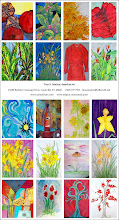"Now, what are these?" he asked.
I explained the cards were ACEOs, small art pieces similiar to the wallet-sized cards European artists from centuries ago gave away to advertise their work. And, although ACEO stands for Art Card Editions and Originals
 , at this time, my cards are original and one of a kind.
, at this time, my cards are original and one of a kind."Cool," he said casually flipping through the stack. "Now, tell me why should I want to buy one."
Easy. ACEOs are an inexpensive way to collect an artist's work.
After he looked through the stack on the table, I directed him to other ACEOs around the room. He chatted about the different styles of cards I offer: ACEOs with original illustrations, collages and watercolors... some embellished with fiber and some with stamps I collected in the late 1970s - early 1980s. (However, my latest ACEO sports a recent postage stamp of Seabiscuit.)
"Nice," he mused hand on his chin. "What would I do with them? Like, where would I put them?"
The possibilities are many. Some collectors keep ACEOs in a photo or card collecting album. Some mat and frame a grouping of the cards. An ACEO can be proped on miniature easel or tacked on bulletin board. They make nice a bookmark, keepsake, card enclosure, meditation piece or graphic element in a scrapbook.
"Great! Thank you! I love your work," he enthused, then shook my hand and left.
Well... I admit I had hoped for a sale, large or small. No such luck. Another day...
Check out my ACEO cards at http://www.smackinart.com/ and http://www.smackinart.etsy.com/.
More about ACEOs:
(1) ACEOs are the size of a sport trading card (2 ½ X 3 ½ inches).
(2) ACEOs are sold, while Art Trading Cards (ATCs) are traded.
(3) The ACEO Movement was founded by artist Lisa Luree.
(4) (information courtesy of Art-Cards.org) Sixteenth century art cards were typically nude paintings of mistresses commissioned by men from the same artists who painted large portraits of their children or wives. Eighteenth century artists used art cards as an advertising tool. Impressionist artists traded art cards among themselves to study and sold or traded to others for supplies, food and lodging.







Great post! I am so addicted to ACEO's, I just love the variety of artwork available at a lower cost than if you were to buy a large painting.
ReplyDelete